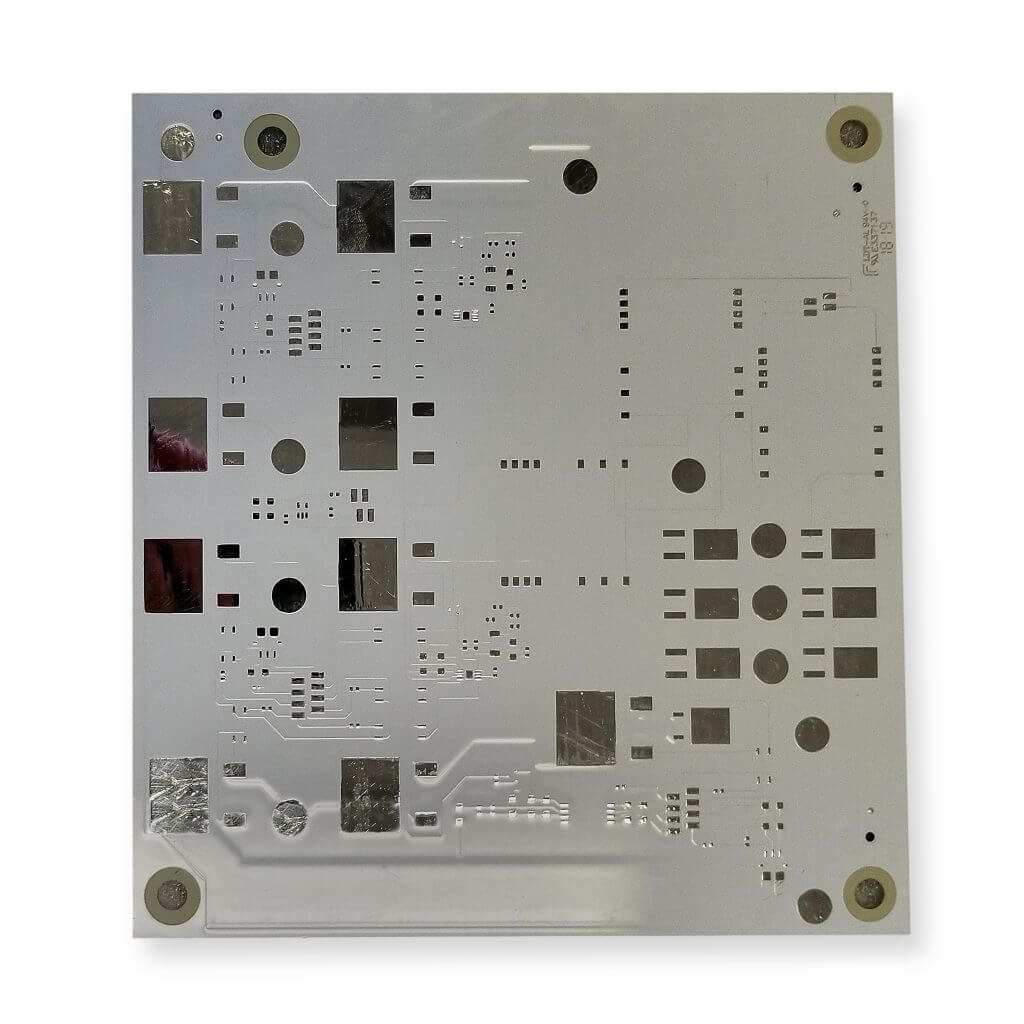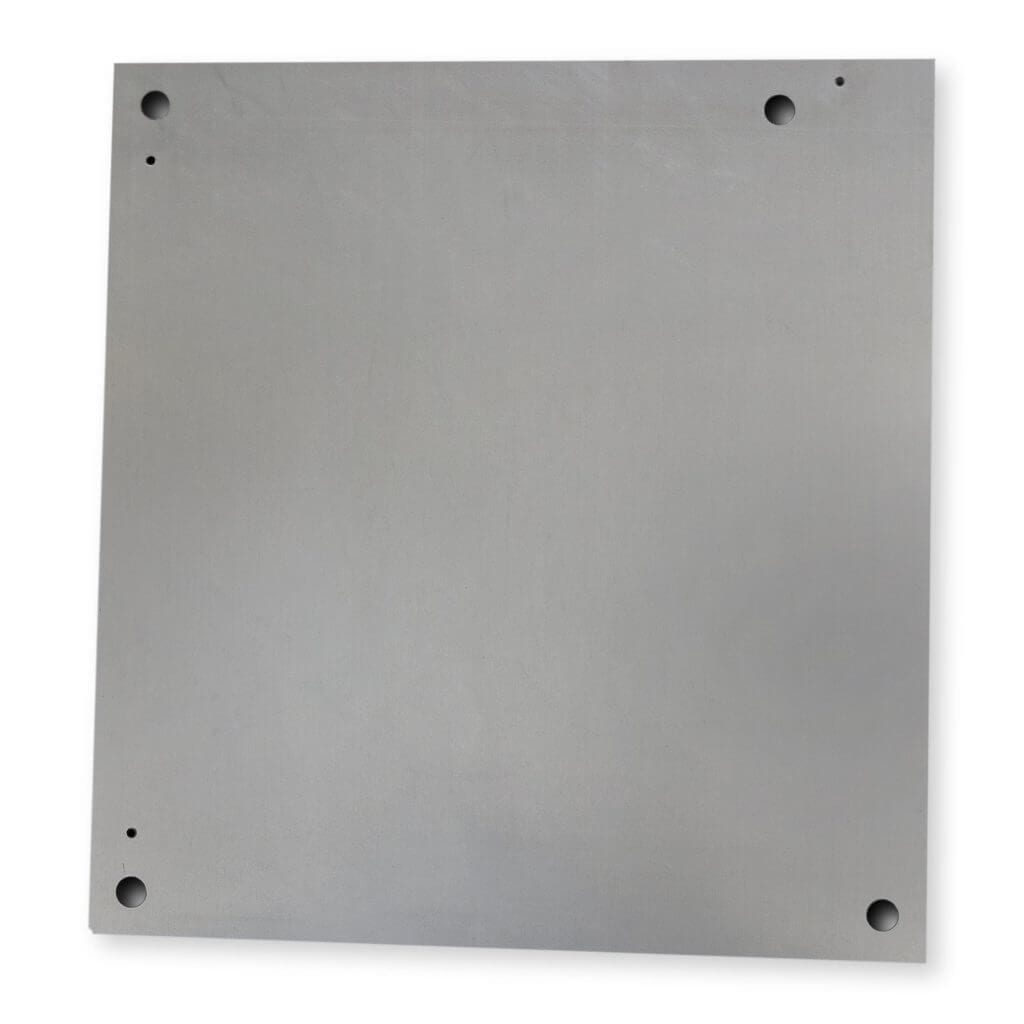
PCB Solutions is a solid source for an Aluminum Printed Circuit Board.
For high-powered LEDs most customers use an aluminum printed circuit board; for low-power LEDs standard FR4 PCBs are available as well. Our PCB fabrication specifications and build most types of metal based Printed Circuit Boards.
Aluminum Based PCBs are a unique metal-based copper clad laminate. These types of Printed Circuit Boards have good thermal conductivity, electrical insulation and very solid machining performance. These types of are typically fabricated with a metal base consisting of aluminum (most common) but can also be produced with copper.
Aluminum Printed Circuit Boards typically contain copper foil, thermal insulating layer and metal substrate, its structure divide into three layers:
- Circuit layer: the equivalent of an ordinary PCB- copper thickness from 1oz to 10oz.
- Insulation layer: Insulation is a layer of thermal insulating material with low thermal resistance. Thickness: 0.003 “to 0.006” inch is the aluminum PCB core technology.
- Base Layer: a metal substrate, usually aluminum or copper.

Advantages and Features:
- Can easily be used for Surface Mount Technology (SMT)
- Assists with thermal diffusion of heat from LEDs
- Reduces product operating temperatures, increases the power density and reliability, and helps to extended product life
- Smaller footprint, lower hardware and assembly costs;
- Replaces fragile ceramic based pcbs, and has better mechanical durability
Capacity
- Max Size: 1200mm x 600mm
- Special Hole: Blind Hole, Blind Slot, T-Hole, T-Slot, Counter Sink Hole, Cup Hole
- Metal Base Thickness: 0.5 – 3.2mm
- Surface Treatment: Hal, ENIG, Chemical Ni Silver, Plated Silver, OSP, ENEPIG
- Working Thickness: 0.5mm – 5.0mm
- Shaping: Tooling Punching, CNC Routing, V-Cut
- Solder Mask Colors: Green, White, Black, Black Matte, Red, Yellow, Blue, Grey
- Minimum Hole Diameter: 0.5mm
| Item | MC PCB (Al base, Copper base, Iron Base |
|---|---|
| Finished thickness | 0.2-6.5mm (Tlr.: +/- 10%) |
| Layers | 1-8 layer |
| Min. Finished hole size | .06mm |
| Base Film thickness | / |
| Base Cu thickness | 0.5-10 OZ |
| Finished Copper T. | 0.5-10 OZ |
| Min. Space/Width | 0.1mm/0.1mm |
| Max. Panel Size | 1700mm*600mm |
| Break Down Voltage | 1-5 kv ac |
| TC | 0.3-10 w/mk |
| Min. Finished thickness | 0.2mm |
| Material | Bergquist, Laird, Denka, Totking, ITEQ, YGA, Huangzheng, etc |
| Surface Finish | HASL, Lead Free HASL, OSP, Immersion Gold, Immersion Silver, Gold Fingers |
| Overlay thickness and Adhesive thickness | / |
| Additional Processes | Peeable mask, Carbon ink, Plated slots and edge, Counter sink, Blind & buried via, via in pad, isolated holes, blind and buried holes, black oxidation, silver jumper |
Aluminum printed circuit boards are a type of circuit board made using aluminum as the base material, unlike traditional PCBs that use fiberglass and woven epoxy or other materials as the dielectric or base layers. Aluminum PCBs are highly efficient in dissipating heat, making them ideal for use in high-power applications.
Aluminum printed circuit boards have a number of advantages over traditional PCBs. They offer improved thermal conductivity, which means that they can handle higher power loads without overheating. They are also more durable and can withstand harsh environments better than traditional FR4 printed circuit boards. Aluminum printed circuit boards are typically less expensive than other high power or high temperature printed circuits utilizing exotic materials such as ceramics or teflon.
Aluminum printed circuit boards are commonly used in a variety of applications, including LED lighting, power supplies, automotive electronics, and aerospace systems. They are also increasingly being used in consumer electronics, such as smartphones and tablets, as manufacturers look for ways to improve performance and reduce heat buildup.
The aluminum PCB manufacturing process involves several steps, including the design and layout of the circuit, laminating a non-conductive dielectric layer and copper foil to the aluminum base, and etching the copper foil to create the circuit pattern. Traditional solder mask may be applied as well as the copper surface finish (ENIG, HASL, OSP, etc.). The final step involves drilling holes and adding any necessary components.
In through-hole aluminum circuit boards, the aluminum is pre-drilled. After that, a dielectric is back-filled into the hole. This dielectric prevents the aluminum from contacting the component pins and shorting due to the conductivity of the aluminum.
Aluminum PCBs offer a number of benefits over traditional PCBs and are an excellent choice for applications that require high power handling, efficient heat dissipation, and durability.
Key features and advantages of aluminum PCBs:
- Thermal management: The aluminum layer in an aluminum PCB acts as a heat sink, dissipating heat away from the components on the board. This makes aluminum PCBs ideal for applications where high power components generate a lot of heat.
- Durability: Aluminum PCBs are highly durable and can withstand harsh environments. They are also resistant to moisture and chemicals.
- Lightweight: Aluminum PCBs are lightweight, making them ideal for applications where weight is a concern.
- Cost-effective: Aluminum PCBs are less expensive than other high-performance PCBs like ceramic PCBs. This makes them a cost-effective solution for high power applications.
- Easy to assemble: Aluminum PCBs are easy to assemble and can be soldered like traditional PCBs.






































